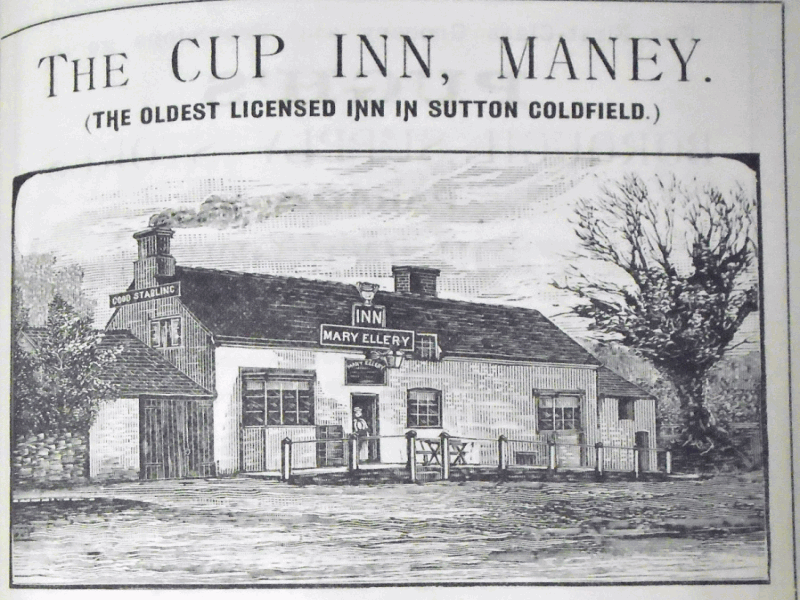The Cup public house ceased trading in 2008, after an existence of over 250 years. The building still stands, at the junction of Manor Hill and Birmingham Road, and is now a restaurant. The present building dates from 1901, but it is on the site of a much older building.
An advertisement for the Cup Inn in a guide to Sutton published in 1893 makes the claim that it was “the oldest licensed inn in Sutton Coldfield.” This claim is hard to prove; the triangle of ground on which the inn stood was almost certainly waste ground in 1528, when Sutton became a self-governing town, and the first building to be erected there was probably a squatter’s hut. The occupant of the hut was allowed to stay, paying an annual rent to the Warden and Society. By 1700 a permanent house had replaced the hut, further extended by 1750 and converted to use as an inn known as The Cock. The name “Golden Cup” was adopted a few years later in response to the mania for horse-racing that developed in the 1780s.
“The Cup Public House, Brewhouse, Stable, and garden” is listed in a survey of Corporation property made in 1811, Thomas Brentnall being the tenant; he was still the licensee in 1841, when he was 75 years old. In the 1830s the inn was a lively place - around 1836 a relative, “Brentnall the watchmaker” set up a bagatelle board there (an early form of bar billiards), presumed to encourage illegal gambling, and “Mr. Croxall informed against it.” The board was eventually burned, but some people still regarded the Cup as a den of iniquity.
The business was next carried on by George Bunn, son-in-law of Thomas Brentnall. Some detail of the buildings is given in the Parochial Valuation of 1856, where the main house of the Cup is stated to be of two storeys, thirty feet long by fourteen feet wide (about nine metres by four), with three two-storey extensions. The outbuildings included a brewhouse, stabling for four horses, a dairy, cowhouse and gighouse.
The 1861 census shows a much younger man as the licensee, Alfred Shepherd, 26, with his wife and infant son. Two girls had been taken on as live-in servants, and the importance of the stabling side of the business is shown by the employment of the eighteen-year-old George Cripps as an ostler. Shepherd is described as “victualler and guard of an omnibus” - this would be his relative Tom Shepherd’s horse-drawn omnibus travelling between Birminham and Sutton.
Joseph Clibbery was the next licensee, running the inn as a family business without any live-in servants, and he was followed by 1881 by the widow Mary Ellery, who lived there with eight of her grandchildren. Her advertisement for the pub in a guide to Sutton of 1893 describes it as within five minutes’ walk of both railway stations and not far from the Wyndley entrance to Sutton Park. The Cup was hoping to attract custom from the visitors to Sutton, advertising first class accommodation for horses and carriages, supplying family parties with wines, spirits, ales and stout, and serving chops, steaks and teas at ten minutes’ notice.
